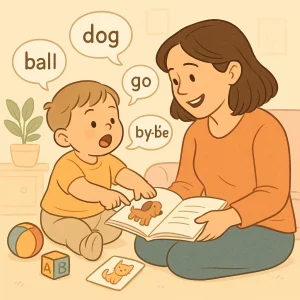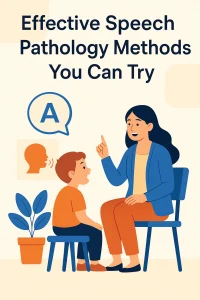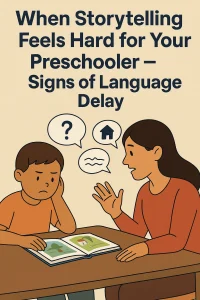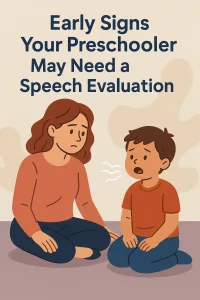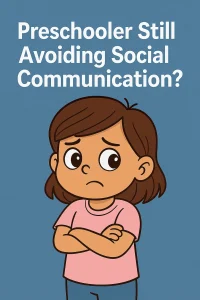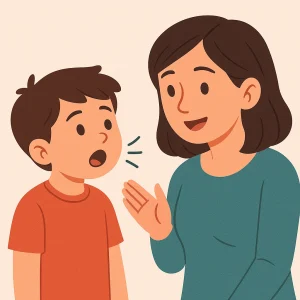Cluttering Speech: Signs, Causes & How to Help Your Child
By Rajini D
Last Updated: May 6, 2024
Have you ever found yourself struggling to follow a conversation because the words seemed to tumble out too fast or perhaps in a jumbled mix that was hard to decipher? This experience may be due to a communication disorder known as cluttering speech. Cluttering is characterized by a rapid and erratic speech rate, making it difficult for listeners to understand what’s being said. The words may flow smoothly but too quickly or be delivered with awkward pauses that disrupt the natural rhythm of speech.
Understanding cluttering speech is crucial for those who live with the condition and their families, friends, and colleagues. By gaining insights into this lesser-known speech disorder, we can improve communication strategies and enhance the quality of life for those affected. Effective communication is key to building connections and achieving success, Whether in school, at work, or in personal relationships. In this article, we’ll explore what cluttering speech involves, how it differs from other speech disorders, and what can be done to manage it effectively.
What is Cluttering Speech?
Cluttering speech is a unique and often misunderstood communication disorder that impacts the flow and clarity of speech. Those experiencing cluttering typically speak unusually rapidly or with an irregular speaking rhythm, resulting in their words coming out in bursts or stopping and starting unpredictably. This can make their speech sound hurried or excessively slow, and it often leads to conversations that can be hard for listeners to follow.
Unlike the more commonly known stuttering, where speech is disrupted by repetitions and prolongations, cluttering is less about the struggle with specific sounds and more about the overall flow of speech. Cluttering involves a lack of control over the pace and rhythm of speech, which can lead to excessive filler words, revisions, and the omission of syllables. It’s as if the person’s mouth can’t keep up with their rapidly firing thoughts, leading to compressed and sometimes slurred speech that can be challenging for others to interpret.
Also Read: What is Stuttering: Types, Symptoms, and Causes
Signs and Symptoms of Cluttering
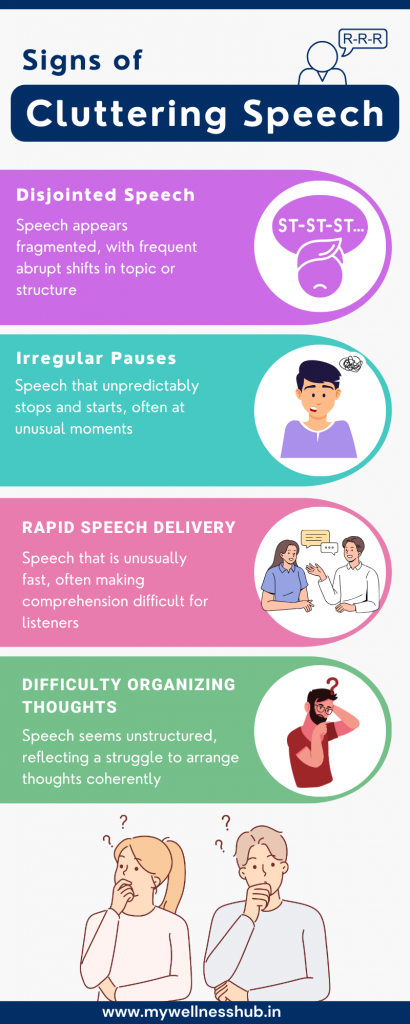
Understanding the signs and symptoms of cluttering is essential for recognizing this often overlooked speech disorder. Individuals who clutter typically exhibit a range of indicators that can vary in intensity and impact communication. Recognizing these signs early can lead to more effective management and support.
Common Symptoms:
- Disjointed Speech: Speech may appear haphazardly pieced together, making it difficult for listeners to follow the speaker’s train of thought. This characteristic can lead to misunderstandings in both personal conversations and professional communications.
- Irregular Pauses: Unlike typical pauses that align with grammatical structures or natural breaths, pauses in cluttered speech may occur unexpectedly, disrupting speech’s natural flow and rhythm.
- Rapid Speech Delivery: Individuals with cluttering often speak unusually fast, complicating the listener’s ability to catch individual words and overall meaning.
Secondary Symptoms:
- Difficulty Organizing Thoughts: People with cluttering may find it challenging to line up their thoughts coherently when speaking, which can result in a conversation that seems scattered or off-point.
- Omission of Sounds: It’s not uncommon for some sounds or parts of words to be dropped altogether in the rush of speech, contributing further to difficulties in understanding.
- Irregular Intonation: The melody of speech, which helps convey emotions and emphasizes certain points, may also be inconsistent, leaving the speech sounding monotone or unusually modulated.
Know more about Speech Sound Disorders: Causes, Treatment and Strategies
Cluttering vs. Stuttering: Understanding the Differences
Cluttering and stuttering are both speech disorders, but they differ significantly in their symptoms and effects on communication. Understanding these differences is crucial not only for accurate diagnosis but also for ensuring effective treatment and support.
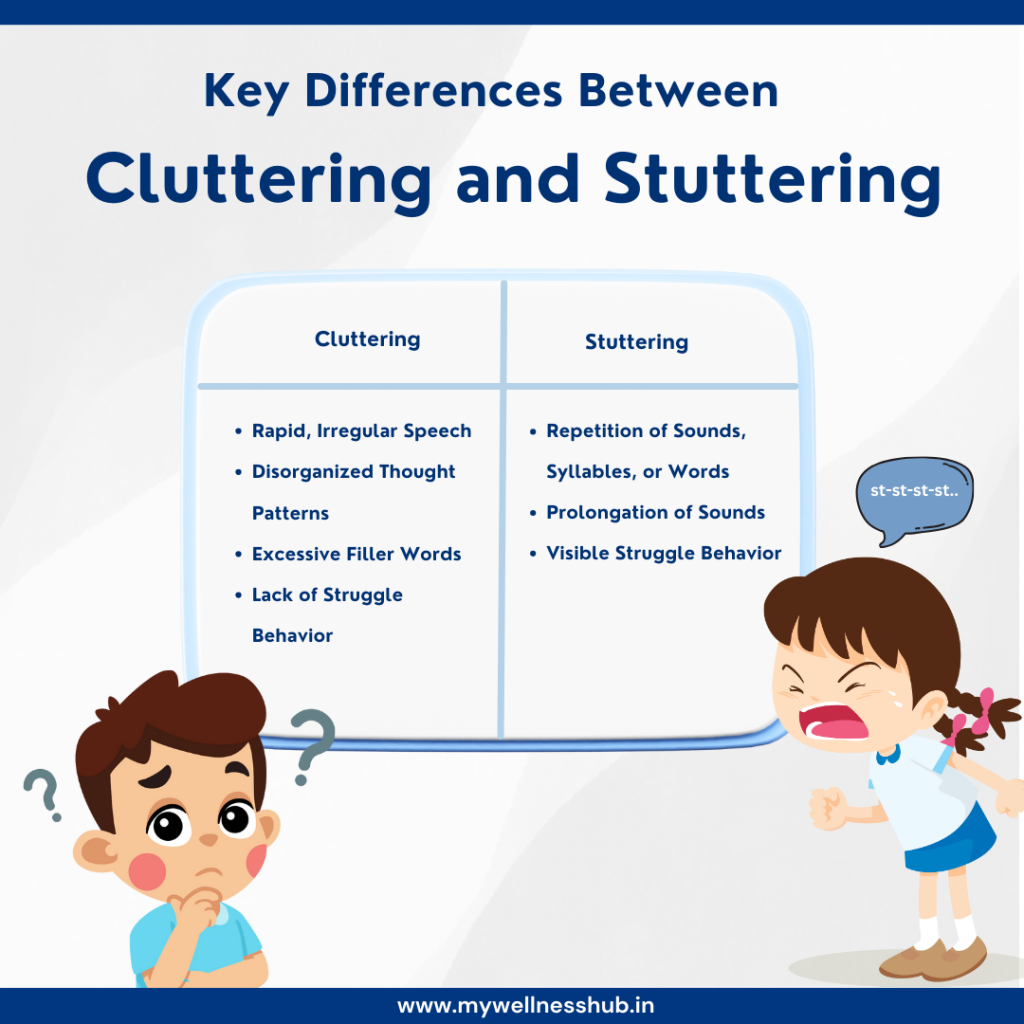
Key Differences in Symptoms and Speech Patterns:
- Cluttering: Individuals who clutter typically speak at an abnormally rapid rate or with a rhythm that feels sporadic and uncontrolled. Their speech may be difficult to understand due to erratic pauses and a tendency to compress words. Cluttering often involves disorganized thought processes reflected in the person’s speech.
- Stuttering: Stuttering is characterized by frequent repetitions of sounds, syllables, or words, prolongations of sounds, and interruptions in speech, known as blocks. Those who stutter often know what they want to say but face difficulty in the flow of speech, which can cause visible frustration.
Explore more on our article Stuttering vs Cluttering: Understanding Speech Disfluencies.
Causes of Cluttering
The causes of cluttering are not entirely understood, making diagnosis and treatment challenging. Researchers continue to explore several potential factors that might contribute to the development of this complex speech disorder. Understanding these factors can help tailor more effective therapies and support systems for those affected.
Neurological Factors:
Some studies suggest that cluttering may be linked to neurological differences that affect speech production. The brain’s language centers must coordinate at incredible speeds to produce smooth, understandable speech. In individuals with cluttering, these processes may not synchronize properly, leading to rapid, irregular speech patterns and difficulties in organizing thoughts coherently.
Genetic Influences:
There is also some evidence to suggest a genetic component to cluttering. This means that the disorder can occasionally be observed running in families, indicating that genetic predisposition may play a role. However, the specific genes involved have not been conclusively identified, and not everyone with a family history of speech disorders will develop cluttering.
Developmental Factors:
Cluttering often becomes apparent in early childhood as speech and language skills develop. It may be associated with other developmental conditions, such as attention deficit hyperactivity disorder (ADHD) or learning disabilities, which can also affect the ability to process and produce language effectively.
Lack of a Definitive Cause and Ongoing Research:
Despite ongoing studies, there is still no definitive cause for cluttering, which remains a significant area of research within speech pathology. This ongoing research is vital as it informs the development of more effective diagnostic tools and treatment strategies that can be customized to individual needs.
How is Cluttering Diagnosed?
Diagnosing cluttering speech disorder is a nuanced process that involves detailed assessments by skilled speech and language pathologists. This diagnosis is essential for determining the most effective treatment and support for individuals experiencing speech difficulties.
Role of Speech and Language Pathologists:
Speech and language pathologists (SLPs) are crucial in diagnosing cluttering. These professionals are trained to observe and analyze speech patterns, rhythm, speed, and the coherence of language use. During an evaluation, an SLP will assess the person’s speaking rate, speech clarity, and the organization of their thoughts during conversation. They may use various tools and techniques, such as recording speech to analyze it more thoroughly or conducting standardized tests measuring speech and language aspects.
Importance of Comprehensive Evaluation:
A comprehensive evaluation is critical to ensure that cluttering is accurately distinguished from other speech disorders like stuttering. This detailed assessment helps to rule out or identify co-occurring conditions such as language processing disorders or attention deficit hyperactivity disorder (ADHD), which can also affect communication. Understanding the full scope of an individual’s speech and language abilities and challenges allows for a more targeted and effective treatment plan.
Diagnosing Cluttering Speech Disorder:
The process of diagnosing cluttering involves multiple steps:
- Collection of Background Information: Gathering detailed histories of the individual’s speech and language development, academic and social performance, and any family history of communication disorders.
- Observation and Assessment: Conducting in-depth assessments may include observing the individual in different settings, like talking one-on-one versus speaking in a group.
- Analysis of Speech Samples: Analyzing recorded speech samples for rate, rhythm, fluency, and sound and syllable repetitions, which helps in distinguishing cluttering from other speech disorders.
Effective Treatment Strategies for Cluttering
When it comes to addressing cluttering speech, there is no one-size-fits-all solution. Individual needs and circumstances are unique, so personalized treatment plans are crucial. Here, we explore effective strategies and treatments that have proven beneficial for individuals dealing with cluttering.
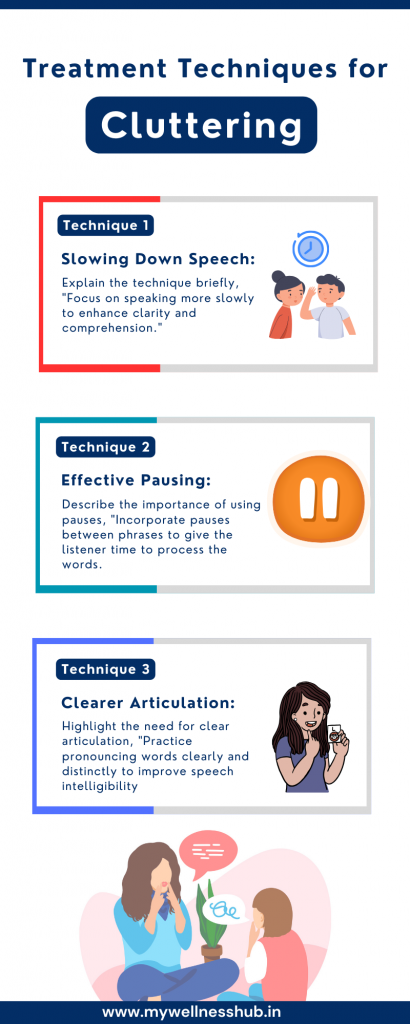
Overview of Treatment Options:
- Speech Therapy: This is the cornerstone of treating cluttering. Speech therapists work with individuals to slow their speech rate, improve their articulation, and structure their thoughts more coherently. Techniques might include using a metronome to pace speech, practicing delayed auditory feedback, and engaging in structured speaking exercises.
- Pacing Techniques: These involve teaching the individual to use physical gestures, such as tapping out a rhythm, to control the pace of their speech. Visual aids and pacing boards are also useful tools that help in maintaining a steady, manageable speech rate.
- Language Therapy: Since cluttering can also affect how thoughts are organized, language therapy is often recommended to improve the structure and coherence of spoken and written language. Exercises may focus on organizing narratives, maintaining topic coherence, and developing strategies to plan out speech before speaking.
Effective Treatment Strategies for Cluttering
| Strategy | Description | Examples |
|---|---|---|
| Speech Therapy | Focuses on techniques to reduce the speed of speech and improve clarity. These techniques help individuals gain better control over their speech patterns, promoting clearer and more effective communication. | Use of Metronome: Helps in pacing speech to a slower, more manageable rate.Delayed Auditory Feedback (DAF): Utilizes technology to echo the speaker’s voice back to them with a slight delay, helping to slow down speech rate. |
| Pacing Techniques | Techniques that help control the pace of speech during conversations, making speech easier to understand for both the speaker and the listener. These methods can help reduce the rush in delivering speech which is common in cluttering. | Finger Tapping: Tapping a finger with each syllable or word to maintain a steady speech rhythm. Visual Aids: Visual cues or pacing boards are used to visually represent the timing and pacing of speech. |
| Language Therapy | Aims at improving the organization and coherence of both spoken and written language. This type of therapy helps individuals structure their thoughts more effectively, which can be particularly beneficial for those who experience disorganized speech as a part of cluttering. | Structured Speech Exercises: Practicing specific speech patterns or phrases to improve organization and flow. Narrative Building: Developing skills to construct clear and coherent stories or explanations, often through guided exercises. |
Living with Cluttering: Practical Tips and Support
Living with cluttering can be challenging, but individuals can manage their speech effectively and improve their communication with the right strategies and support. Here are some practical tips and ways that family and friends can help, making daily life with cluttering more manageable.
Daily Strategies to Manage Cluttering:
- Practice Deliberate Speech: Take time each day to practice speaking slowly and deliberately. Use short sentences and pause frequently to ensure clarity and give yourself time to organize your thoughts.
- Use Tools and Technology: Tools like metronomes or apps that provide delayed auditory feedback can help maintain a slower, more controlled speech rate. Practicing with these tools can gradually improve speech patterns over time.
- Visual Aids: Keep a notepad or digital device handy to jot down or organize thoughts before speaking. This can help structure communication more effectively, reducing the pressure and anxiety that might come with spontaneous speech.
- Regular Therapy Sessions: Engage in regular speech therapy sessions to learn and practice techniques tailored to manage cluttering effectively. Consistency is key to progress.
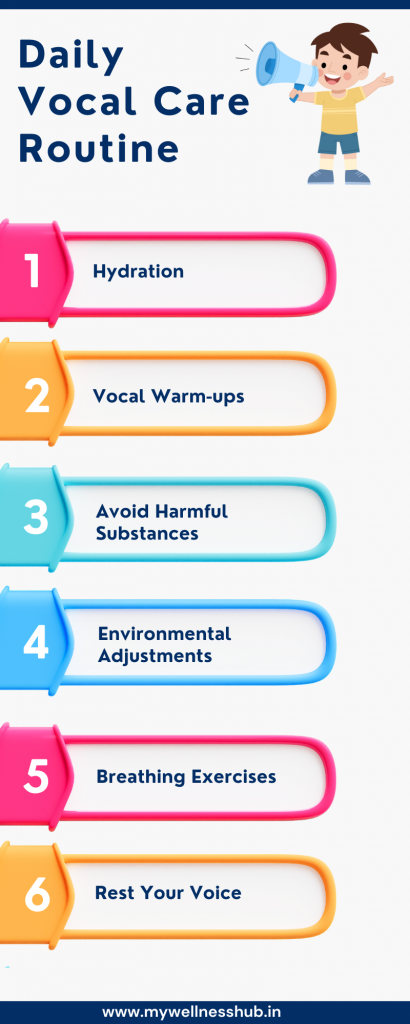
How Family and Friends Can Support Individuals with Cluttering:
- Be Patient and Attentive: Give your full attention when listening to someone cluttering. Avoid interrupting or finishing sentences, as this can create stress and disrupt their flow of speech.
- Encourage Practice: Encourage daily practice by engaging in structured conversations to practice specific techniques learned in therapy.
- Create a Supportive Environment: Reduce background noise and distractions during conversations to help focus and clarity.
- Positive Reinforcement: Celebrate improvements and efforts, no matter how small. Positive reinforcement can boost confidence and motivate continued effort.
Conclusion
Understanding cluttering speech helps us recognize how it affects communication and daily life. Acknowledging that those experiencing cluttering are not alone and can improve with the right support is important. Seeking help from skilled speech therapists can significantly improve speech patterns, making communication easier and more effective.
At Wellness Hub, we are committed to assisting individuals with communication challenges. Our experts provide personalized guidance and therapy tailored to each person’s needs. For more information on how we can help or to access additional resources, please visit our website. Together, we can make strides toward clearer and more effective communication.
Frequently Asked Questions:
1. What is cluttering in speech?
Cluttering is a fluency disorder characterized by a rapid and irregular speech rate, which makes it difficult for others to understand. It often involves erratic rhythms, excessive filler words, and poor sentence structure.
2. How is cluttering different from stuttering?
While both cluttering and stuttering affect speech fluency, cluttering involves irregular speech flow without the typical repetitions and prolongations seen in stuttering. Cluttered people may speak quickly and skip parts of words, making their speech difficult to follow.
3. What are the signs of cluttering speech?
Signs of cluttering include excessively fast and jerky speech, unnecessary pauses, and a lack of rhythm or melody in speech. Individuals may also show disorganized thought patterns and difficulty communicating their ideas effectively.
4. Can cluttering speech be treated?
Yes, cluttering can be effectively managed with speech therapy. Treatment often involves techniques to slow down speech rate, improve articulation, and organize speech more coherently. Regular practice and support from a qualified speech therapist can greatly enhance communication skills.
5. What causes cluttering speech?
The exact causes of cluttering are poorly understood, but it may involve neurological, genetic, or developmental factors. Ongoing research continues to explore these areas to understand and treat the disorder better.
6. How can family and friends support someone with cluttering?
Family and friends can support individuals with cluttering by being patient and providing a supportive and understanding environment. Encouraging and participating in regular speech practice can also be very helpful, as can avoiding interrupting or finishing sentences for the person.
7. Where can I find more resources on cluttering speech?
Wellness Hub offers a range of resources on cluttering and other speech disorders. Visit our website to find detailed articles, therapy options, and support tools to help manage cluttering effectively.
8. What age does cluttering typically start to appear in individuals?
Cluttering often becomes noticeable in early childhood as children develop their language and speech skills. However, it can sometimes go unrecognized until later when communication demands increase in more complex social or educational settings.
9. Are there specific exercises to help reduce speech cluttering?
Yes, specific exercises can help manage cluttering. These include:
- Pacing Drills: Using a metronome or tapping a finger to maintain a slower and more regular speech pace.
- Breathing Techniques: Learning to take breaths at natural pauses rather than speaking rapidly and running out of breath.
- Scripting and Rehearsing: Planning out what to say beforehand can help organize thoughts and reduce the rush in speech delivery.
10. How do I know if I should consult a professional about cluttering?
If you or someone you know frequently exhibits symptoms like rapid, disorganized speech, difficulty in being understood, and erratic pausing in conversations, it might be beneficial to consult a speech-language pathologist. These professionals can provide a comprehensive evaluation and, if necessary, a tailored treatment plan to manage the disorder.
About the Author:
Rajini Darugupally
M.Sc., Speech-Language Pathologist (9+ years of experience)
Rajini is a passionate and dedicated Speech-Language Pathologist with over 9+ years of experience, specializing in both developmental speech and language disorders in children and rehabilitation in adults. Driven by a desire to empower each individual to find their voice, Rajini brings a wealth of experience and a warm, genuine approach to therapy.
Currently, at Wellness Hub, she thrives in a team environment that values innovation, compassion, and achieving results for their clients.
Connect with Rajini to learn more about how she can help you or your loved one find their voice.
Book your Free Consultation Today
Parent/Caregiver Info:
Client’s Details:
* Error Message


